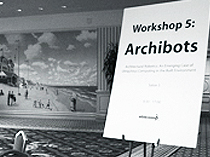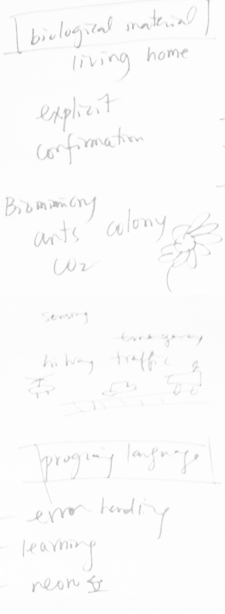
WORKSHOP ACM UBICOMP DOC
EXTENDED ABSTRACTS
STOP MOTION VIDEOS
...envisioning archibots in 2019, created by pairs of workshop participants in three hours
WORKSHOP INTRODUCTION
15 MIN. OVERVIEW OF PAPERS
BRAINSTORMING | GROUP-1
BRAINSTORMING | GROUP-2
BRAINSTORMING | GROUP-3
BRAINSTORMING | GROUP-4
FULL PAPERS [restricted]
COLLECTED PAPER CITATIONS

|
|
workshop motivations and overview
The Archibots workshop identified opportunities and challenges in research and education in the emerging area of “Architectural Robotics” - intelligent and adaptable physical environments at all scales. In the coming decades, robotics embedded in our built environment will support and augment everyday work, school, entertainment, and leisure activities in an increasingly digital society.
Archibots was a full-day workshop offered on September 30, 2009 in Orlando, Florida as part of Ubicomp, the International Conference on Ubiquitous Computing. Workshop co-conveners Keith Evan Green (Clemson U.) and Mark D. Gross (Carnegie Mellon U.) direct graduate programs in architecture and computation and conduct research in architectural robotics.
Read our workshop proposal to the U.S. National Science Foundation
workshop scope and contributions
For Archibots 2009, the organizers collected position papers representing diverse perspectives. Workshop extended abstracts, full papers [access restricted] and their collected citations capture a broadly interdisciplinary readership in architecture, human-centered computing and interaction design, robotics, and new media studies. The authors are an international group of researchers and practitioners working in these fields. Position papers present not only the contributions of individual authors, but also envision more broadly (and speculatively) implications for architectural robotics for the next decade and beyond, including:
• Specific applications (e.g., work, health, play, elderly, disabled, children).
• Re-configurable and modular robotics in buildings, public places, furniture..
• Societal and psychological implications of architectural robotics.
• Programming buildings that sense, infer, and respond to human needs.
• Intelligent building structures and systems with embedded robotics.
• Required software and hardware infrastructure.
• Teaching and learning architectural robotics.
• Specific applications (e.g., work, health, play, elderly, disabled, children).
• Re-configurable and modular robotics in buildings, public places, furniture..
• Societal and psychological implications of architectural robotics.
• Programming buildings that sense, infer, and respond to human needs.
• Intelligent building structures and systems with embedded robotics.
• Required software and hardware infrastructure.
• Teaching and learning architectural robotics.

Workshop participants discussed these perspectives initially as the larger group and, subsequently, as rotating panels of 4 to 5 participants with non-panelists serving as the (active) audience. Participants then assembled into four teams for brainstorming sessions, which resulted in presentations from teams 1, 2, 3 and 4. The same teams sketched short videos to envision possible futures. The collected videos of the workshop were streamed to the Video Program of the larger Ubicomp conference.
The workshop papers, discussions and other workshop outcomes aimed to go beyond mere presentations of accomplished works: the ambition was to establish and project techniques, methods and assemblies of architectural robotics and, more broadly, the larger challenges and prospects of architectural robotics, recognized as technical, social and aesthetic.
support
The organizers acknowledge support for the workshop from the U.S. National Science Foundation under grant number IIS-0925238. The "ARCHIBOTS Luncheon" was generously sponsored by Aedas.
|
|





